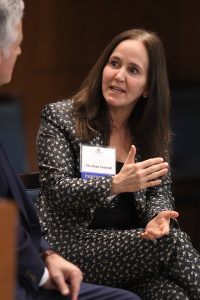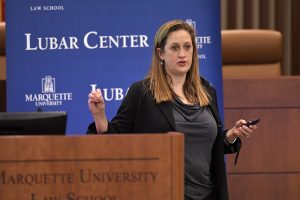(This is a lightly-edited version of a column I wrote for the Milwaukee Journal Sentinel that ran in the Dec. 8, 2019, print edition.)
Dana Suskind is a surgeon at the University of Chicago whose specialty is providing kids who have little or no hearing with high-tech cochlear implants that allow them to hear much better. But she noticed about a decade ago that some of her young patients had much better outcomes than others after receiving the implants.

“It was a really painful experience to watch” kids who now could hear but weren’t thriving. She worked to find the reason. Her conclusion: The problem “had less to do with their hearing loss and more to do with the environment into which they were born.” Generally, their lives were shaped by poverty, instability, high stress and limited exposure to experiences that are intellectually and emotionally beneficial.
Much the same is true for millions of children who are born with normal hearing. By the time they reach kindergarten, they are nowhere near as ready for school as children who with better lots in their early years.
Suskind became founder and co-director of a project called Thirty Million Words. The name came from a study from several decades ago that concluded that, by the time they reached school age, low-income children had heard 30 million fewer words in every-day conversation than children from higher income homes. This limited their educational readiness.
The specific claim about 30 million words has been challenged by more research. But the underlying premise about big gaps in school readiness is indisputable.
Suskind’s organization, now known as the TMW Center for Early Learning and Public Health, works to promote healthy brain development in children by trying to build “a population level shift in what parents know and believe about their importance,” as Suskind put it. To put it another way, with some coaching and other help, a lot more parents could help their kids a lot more.

Is Suskind’s message important? For sure. Just look around the Milwaukee area, where lots of children have excellent early childhood experiences and lots don’t. And you know overall where they live.
Is this a moment when more will be done to close the pre-kindergarten education gap? Maybe. There is more recognition of the need. There seems to be more percolating to increase efforts. This is fundamentally a concern that is recognized on a wide and bipartisan basis.
But actual change? And what would it be?
About 200 people, many of them involved in early childhood work, took part in a morning-long conference at Marquette Law School on Wednesday, on just this. It’s a little awkward for me to write about this because I was an organizer and participant. But, given the importance and timeliness, I’m doing it anyway.
Suskind and Katherine Magnuson, director of the Institute on Research on Poverty at the University of Wisconsin-Madison, keynoted the session.
Magnuson said, “Those inequalities that we see at 16, 17 or 18 are present when kids enter school. Those first five years forecast what comes later.” Overall, she said, achievement gaps don’t grow or shrink from kindergarten through twelfth grade – low-income kids stay fairly steadily at a level a year behind richer kids.
Magnuson said parents who provide reliable support and protection from harm are big plusses for little kids. But not all children have the benefit of that. For many reasons and for people at all income levels, early childhood centers are keys to daily life. Do they help? Magnuson presented a chart summarizing research on such programs around the county, going back several decades. The overall conclusion: They have positive effect, some more than others.
Where could we go from here?
Magnuson and others said that helping parents meet daily needs, including shelter and food, pays off in real gains for children. It should be less stressful and less bureaucratic to get help that people are qualified to get and to get information about things such as good child care programs. She also said Wisconsin should encourage more innovation in efforts to increase the success of early childhood efforts.
Tracey Sparrow, president of Next Door, which operates two large early childhood centers on the north side, said, “The work force is probably our biggest concern.” Next Door has 30 teacher openings, due in large part to poor pay for early childhood jobs.
Magnuson said, “I’d like to tell you, here’s what you can do to get people into the field and pay them no money and have them be really skilled and stay. But your basic Econ 101 says that’s not sustainable, it doesn’t work.” This is, in short, one area where more money seems to be needed.
Laura Gutierrez, associate director of the United Community Center on the south side, which is expanding its early childhood program, urged a major public information campaign to increase recognition that quality efforts at home and in the community around early childhood development are important.
Tom Schneider, executive director of COA Youth & Family Centers, said strengthening the community fabric overall is a big need. He said that while he is an advocate for strong schools, more people need to understand the crucial nature of development in early years. “It’s hard to build a skyscraper if you’re going to start construction on the fifth floor,” he said.
Suskind said that, as a doctor, her focus is largely on ways the medical system could do more, right from birth, to help parents with intellectual growth of their children and not only with physical health.
John Johnson, research fellow with the Law School’s Lubar Center, presented graphics shedding light on where state-licensed early childhood programs are located in Milwaukee County and how the programs fare on the state’s YoungStar rating system (one to five stars). One striking fact that his work demonstrated was the high number of two-star centers across much of the City of Milwaukee’s north side and the low number of four- or five-star centers.
Suskind was asked what is realistic to hope for. “What is realistic is understanding that every child is born with a promise and his or her right to have that healthy brain development from day one. And it is our responsibility to think intentionally about how we make that happen.”
She added, “At the end of the day, early childhood has less to do with the children than with the adults in their world.”
Video of the morning-long conference may be viewed by clicking here.
